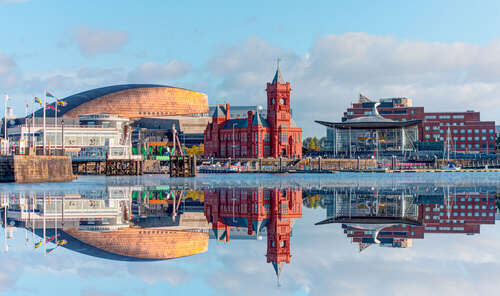
The history of Wales is rich with a unique cultural identity. Welsh Celts’ success in fending off Anglo-Saxon assaults in the fifth century led to the establishment of the kingdoms that linked the region and served as one of the key components of the UK. But in the modern day, how many cities are there in Wales?

How many cities are there in Wales?
Wales is home to seven major cities. They all have distinctive traits, populations and histories.
Cardiff
Wales’ capital, Cardiff, has a population of about 362,000 people. In addition to being the nation’s capital, it also acts as a hub for culture and entertainment.
One of the city’s main attractions is Cardiff Castle, a Roman fort that was extensively renovated by William Burges in the 19th century. Cardiff’s abundant green spaces, like Bute Park, make it a pleasant and charming city to stroll around.
Newport
The main port for shipping coal from Wales is Newport, which lies north-west of Cardiff. Newport is still a significant industrial hub today.
The city’s most notable monument is the Newport Transporter Bridge, one of only six active transporter bridges worldwide.
Swansea
Due in part to the existence of the urban university, Swansea, the second-largest city in Wales, has a significant cultural weight and places a heavy focus on Welsh history.
The Gower Peninsula in Swansea is one of Wales’ most stunning landscapes, and it was the first place in the UK to be designated as an Area of Outstanding Natural Beauty (AONB).
Bangor
Bangor derives its name from the Welsh word for wattle fence. The fence once enclosed a monastic colony erected in 525 CE by Celtic missionary Saint Deiniol, making Bangor the oldest city in Wales. Twenty years later, Saint Deiniol was consecrated as a bishop by King Maelgwn of Gwynedd and subsequently turned the church into a cathedral.
Following several repairs after clashes between the Welsh and English in the 1800s, the cathedral underwent its largest restoration in 1866 under Sir Gilbert Scott, who renovated it as we see it today.
Politically, on the other hand, Bangor was not considered a city until Queen Elizabeth II gave it city status in 1974.
Bangor is home to Wales’ longest high street and Penrhyn Castle, a National Trust site, both of which can be seen from Bangor Garth Pier — which was voted Pier of the Year 2022.
Wrexham
Only in 2022, following a successful bid for city status as part of the Queen’s Platinum Jubilee, was Wrexham officially designated as Wales’ seventh city.
It is situated in north-east Wales and boasts a number of interesting historical characteristics, such as the third-oldest football team in the world, Wrexham AFC. The club has become popular recently due to a takeover from actors Ryan Reynolds and Rob McElhenney and the subsequent FX show, Welcome to Wrexham.
St Asaph
With a population of around 3,500, St Asaph is the second-smallest city in both Wales and the UK. The smallest historic cathedral in the UK, St Asaph Cathedral, was constructed there in the 13th century.
St David’s
The smallest city in the UK is St David’s in Pembrokeshire. St David, the patron saint of Wales, was born and died there, thus the name.
Due to its coastal location, St David’s is used as both a starting and finishing point for boat trips which take tourists to look for wildlife.
What is the biggest city in Wales?
Cardiff is the biggest city in Wales and ranks as the 13th largest city in the UK, with a population of more than 362,000.
Cardiff received city status in 1905 and was designated as the Welsh capital’s administrative centre in 1999. As a consequence, the Senedd, the nation’s legislative building, opened in 2006.
With a multicultural centre, several historical buildings, and iconic locations, Wales’ capital is also perhaps its most well-known tourist attraction. For instance, one can visit its two cathedrals: Metropolitan Cathedral Church of St David and Llandaff Cathedral. It has also been ranked as the third-best capital in Europe to live in according to an EU survey.
Cardiff Bay, the city’s social centre with a variety of restaurants, bars, and cafés, is another well-known location. In addition, Wales’ premier historical site is Cardiff Castle. It is strategically located, and its Romanesque antique walls encase its 2,000-year history. The castle has been in many different hands, acting as a Roman fort, a Norman fortification and a Victorian home.
Is Wales a country?
Wales is indeed a country — one with its own devolved government and unique national character. However, it is still part of the UK alongside Scotland, England and Northern Ireland, so it is not a sovereign state.
In general, there are two types of countries: constituent and sovereign. The former is part of a bigger country but does not have full control, especially in law-making, and the latter has complete autonomy over all bureaucratic aspects. In the case of Wales law-making is carried out by the Senedd, which has control over policies areas such as health, education and housing, but not areas like justice, foreign policy or defence.
Formerly, Westminster served as the seat of the UK government as a whole, including non-English nations. However, a democratic vote led to the establishment of a National Assembly for Wales in 1997 and the subsequent devolution of powers.
[Read more: What are the UK’s fastest-growing cities?]






